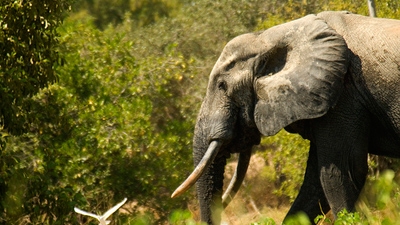Environmental Crime Destroys Development
Environmental and natural resources form the foundation of millions of people’s livelihoods: Fishermen rely on being able to fish the oceans; forests provide everything from food to fuel for rural communities; and wildlife can be a tourist attraction, generating millions of dollars of income for developing countries. Environmental crime damages these livelihoods, robbing the many to enrich the few.
Environmental crime inherently fuels corruption and elite capture, driving poor decision-making. This can occur at a micro-level, when a government official intercepts looters, but extends all the way to entire financial systems that are abused for money laundering purposes.
Environmental crime risks undermining investments in biodiversity conservation. For example, a newly established national park is of limited value if poachers can take their prey almost at will and decimate the very resources the park is intended to protect.
Organized crime also deprives developing countries of scarce income. The Environmental Justice Foundation estimates that Guinea loses $105 million worth of fish to pirate fishing yearly, Sierra Leone $ 29 million, and Liberia $12 million. In illegal trading, few monetary resources flow into the source country: In one example, Indonesian loggers received $20 per cubic meter of illegal timber (pdf), which Malaysian business people subsequently sold for ten times as much, leaving 90 per cent of revenues outside of the source country. Most developing countries can ill-afford lost income, whether private, in the form of incomes or depressed prices in legal markets due to increased supply, or public, in the form of taxes and royalties.
Lack of action
Given the magnitude of the illicit business and its negative impacts, one might expect governments to accord higher importance to environmental crime. But in actual fact, relatively little is being done about it. Most countries do not treat environmental crime as a “mainstream crime” in the same way that they would treat common theft, fraud, corruption or money laundering. Yet these are exactly the types of acts that criminals commit when they engage in environmental crime.
Since the value of natural resources – in particular fisheries and wildlife – is generally unaccounted for, it is hard for governments to fully appreciate their value. As a result, their legal systems and law enforcement bodies – already thinly stretched due to underfunding and competing demands – do not have the capacity or resources to deal with the epidemic of environmental crime. This allows the entry of organized criminal networks that already traffic drugs or humans.
Prevention, detection, suppression, recovery
In light of the rise in environmental crime, the World Bank is helping its clients conserve their natural resources by placing an increased focus on law enforcement. This forms part of a holistic approach to crime that encompasses prevention, detection, suppression, and recovery. Prevention will continue to form the backbone of World Bank activities. This strategy focuses on ways to “crowd out” environmental crime by increasing the effort necessary to commit the crime and increasing the risks of doing so.
“The goal of prevention is to ensure that the values of conservation accrue to national economies and local communities,” says Valerie Hickey, Biodiversity Specialist, The World Bank.
In order to deal with environmental crime, detection will also be necessary. Detection revolves around several methods: Direct observation, recognition of losses and the analysis of discrepancies in records, statistics and transactions. The emphasis is again on pursuing those at the apex of criminal networks.
Crime suppression is necessary as a strategy of last resort. Suppression is concerned with the criminal justice system – pursuing, convicting and imposing sanctions against criminals.
This approach can pay off. An ongoing World Bank project in West Africa had early success when the Liberian government – equipped with new regulations, a new fisheries monitoring center, and satellite monitoring – seized an illegally fishing foreign trawler and collected fines exceeding $175,000. The revenue stream from this and other in-port arrests alone have led to a tripling of public revenues from fisheries between 2010 and 2011, albeit starting from a minimal base.

